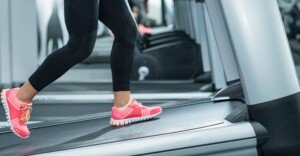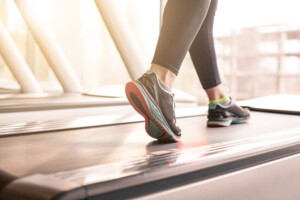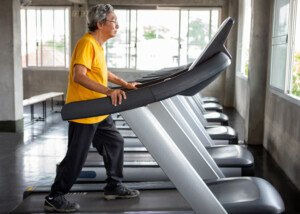
Ask your surgeon and/or breast care nurse if it’s okay to walk on a treadmill right after you get home from your double mastectomy.
First I need to qualify that this information is based on my experience with a prophylactic double mastectomy without reconstruction. I’m also a former personal trainer.
Prior to the surgery the breast care nurse told me that I will need to be walking as soon as possible after the operation – to prevent constipation.
I believe she anticipated that I’d be in enough pain to want a narcotic drug; these drugs can cause constipation.
However, I did not have pain, only a tolerable amount of soreness, but soon after the surgery I was wanting to walk the corridors.
There were no restrictions on how often I could leave my hospital room and walk the hallways, or how long each hallway walk lasted.
The surgeon told me I could walk all I wanted, based on my comfort level, once I got home the day after the preventive double mastectomy. But he said don’t use a treadmill incline higher than 20 percent.
The next day I took it quite easy, but the day after I was on my treadmill desk while using the computer.
And since then I’ve been using the treadmill desk – and my regular treadmill. Ever hear of the “sitting disease”?
Having undergone a prophylactic double mastectomy doesn’t exempt you from the dangers of prolonged sitting.
So I’ve been walking as much as possible on my treadmills as well as outdoors.
Guidelines for Walking on a Treadmill Soon After Double Mastectomy

Again, this information applies primarily to those who’ve had a prophylactic procedure without reconstruction.
• Don’t let the JP drains stop you from walking. They should be held in place by a miniature smock or apron that goes beneath your shirt.
• Drains can also be pinned to your pants and hidden under your top.
If you’re on a narcotic painkiller and hence feel dizzy or off-balance, it’s advisable to avoid the treadmill.
My guidelines pertain to those who are not on any medications that can alter balance, cause unsteadiness or dizziness.
It stands to reason that good posture should be a part of your surgical recovery.
There is no medical reason, then, why you should hold onto the treadmill OTHER THAN to steady yourself while sipping water or as a brief balance check.
But as part of the walking routine itself, you don’t need to hold on. A double mastectomy will not affect your balance and require you to hold onto the treadmill.
If your balance is wavering, however, then get off the machine and find out why there’s a balance issue. I understand that losing large breasts can make a woman feel a bit off-center.
But the best way to re-establish a feeling of balance is to force your body to adapt to a balance stimulus, such as walking on a treadmill without holding on.
GO SLOWLY. Start out at one mph. When I was a trainer I was always seeing people walking at high inclines and high speeds and clutching the machine.
Start level and slowly, and build up your speed from there. By not holding on you force your body to have good posture and correct gait mechanics, as well as maximal breathing efficacy.
If it hurts to swing your arms, then keep them at your sides with minimal movement rather than holding onto the machine.
If you lock down your arms by holding onto the machine, this lockup will do you NO favors as far as preventing things from tightening up around your shoulders and chest.
Right after a double mastectomy, walking on a treadmill will increase blood circulation which will contribute to the healing process.
 Lorra Garrick is a former personal trainer certified by the American Council on Exercise. At Bally Total Fitness she trained clients of all ages for fat loss, muscle building, fitness and improved health.
Lorra Garrick is a former personal trainer certified by the American Council on Exercise. At Bally Total Fitness she trained clients of all ages for fat loss, muscle building, fitness and improved health.
.

























